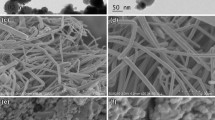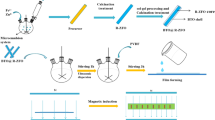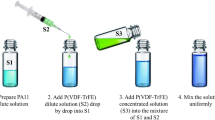Abstract
Interface functional groups play an essential role in regulating the electrical properties of bulk materials. In this work, we designed a novel strategy to explore a new way to enhance triboelectric performance by regulating the functional groups between nano-fillers and polymer matrix without obvious changes in the dielectric constant. The silica nanoparticles (SNPs) modified perfluoro-silane coupling agents (PFSCAs) with different chain lengths were added to the polyvinylidene difluoride to regulate the transferred charge density (TCD) of triboelectric nanogenerators (TENGs). When the doping concentration of perfluorodecyl modified SNPs is 2.25 wt.%, the nanocomposite film based TENG exhibits the maximum TCD of 166 µC/m2 and power density of 3.12 W/m2 which are 6 times and 39 times as big as those of pure polyvinylidene difluoride (PVDF) film. The charge accumulation and decay process show that interface functional groups dominate the performance of TENGs. Then, a Fermi level model is proposed and why the TCD could be regulated by the concentration of nanoparticles in bulk materials is explained. This work provides a new concept for understanding the performance of TENG independent dielectric constant and points out a new direction for enhancing TENG’s performance, since wealthy functional groups with selectivity are applicable.

Similar content being viewed by others
References
Wang, Z. L. On Maxwell’s displacement current for energy and sensors: The origin of nanogenerators. Mater. Today 2017, 20, 74–82.
Shao, J. J.; Yang, Y.; Yang, O.; Wang, J.; Willatzen, M.; Wang, Z. L. Designing rules and optimization of triboelectric nanogenerator arrays. Adv. Energy Mater. 2021, 11, 2100065.
Li, X.; Zhu, P. C.; Zhang, S. C.; Wang, X. C.; Luo, X. P.; Leng, Z. W.; Zhou, H.; Pan, Z. F.; Mao, Y. C. A self-supporting, conductor-exposing, stretchable, ultrathin, and recyclable kirigami-structured liquid metal paper for multifunctional E-skin. ACS Nano 2022, 16, 5909–5919.
Tang, Y. J.; Zhou, H.; Sun, X. P.; Diao, N. H.; Wang, J. B.; Zhang, B. S.; Qin, C.; Liang, E. J.; Mao, Y. C. Triboelectric touch-free screen sensor for noncontact gesture recognizing. Adv. Funct. Mater. 2020, 30, 1907893.
Zhou, H.; Huang, W.; Xiao, Z.; Zhang, S. C.; Li, W. Z.; Hu, J. H.; Feng, T. X.; Wu, J.; Zhu, P. C.; Mao, Y. C. Deep-learning-assisted noncontact gesture-recognition system for touchless human—machine interfaces. Adv. Funct. Mater. 2022, 32, 2208271.
Wang, S. H.; Lin, L.; Wang, Z. L. Nanoscale triboelectric-effect-enabled energy conversion for sustainably powering portable electronics. Nano Lett. 2012, 12, 6339–6346.
Zhu, G.; Lin, Z. H.; Jing, Q. S.; Bai, P.; Pan, C. F.; Yang, Y.; Zhou, Y. S.; Wang, Z. L. Toward large-scale energy harvesting by a nanoparticle-enhanced triboelectric nanogenerator. Nano Lett. 2013, 13, 847–853.
Zhu, G.; Pan, C. F.; Guo, W. X.; Chen, C. Y.; Zhou, Y. S.; Yu, R. M.; Wang, Z. L. Triboelectric-generator-driven pulse electrodeposition for micropatterning. Nano Lett. 2012, 12, 4960–4965.
Song, G.; Kim, Y.; Yu, S.; Kim, M. O.; Park, S. H.; Cho, S. M.; Velusamy, D. B.; Cho, S. H.; Kim, K. L.; Kim, J. et al. Molecularly engineered surface triboelectric nanogenerator by self-assembled monolayers (METS). Chem. Mater. 2015, 27, 4749–4755.
Wen, R. M.; Guo, J. M.; Yu, A. F.; Zhang, K.; Kou, J. Z.; Zhu, Y. X.; Zhang, Y.; Li, B. W.; Zhai, J. Y. Remarkably enhanced triboelectric nanogenerator based on flexible and transparent monolayer titania nanocomposite. Nano Energy 2018, 50, 140–147.
Firdous, I.; Fahim, M.; Wang, L. Y.; Li, W. J.; Zi, Y. L.; Daoud, W. A. Boosting current output of triboelectric nanogenerator by two orders of magnitude via hindering interfacial charge recombination. Nano Energy 2021, 89, 106315.
Wang, H. L.; Guo, Z. H.; Zhu, G.; Pu, X.; Wang, Z. L. Boosting the power and lowering the impedance of triboelectric nanogenerators through manipulating the permittivity for wearable energy harvesting. ACS Nano 2021, 15, 7513–7521.
Wen, R. M.; Guo, J. M.; Yu, A. F.; Zhai, J. Y.; Wang, Z. L. Humidity-resistive triboelectric nanogenerator fabricated using metal organic framework composite. Adv. Funct. Mater. 2019, 29, 1807655.
Cui, N. Y.; Gu, L.; Lei, Y. M.; Liu, J. M.; Qin, Y.; Ma, X. H.; Hao, Y.; Wang, Z. L. Dynamic behavior of the triboelectric charges and structural optimization of the friction layer for a triboelectric nanogenerator. ACS Nano 2016, 10, 6131–6138.
Kim, D. W.; Lee, J. H.; You, I.; Kim, J. K.; Jeong, U. Adding a stretchable deep-trap interlayer for high-performance stretchable triboelectric nanogenerators. Nano Energy 2018, 50, 192–200.
Tang, N.; Zheng, Y. B.; Yuan, M. M.; Jin, K.; Haick, H. High-performance polyimide-based water—solid triboelectric nanogenerator for hydropower harvesting. ACS Appl. Mater. Interfaces 2021, 13, 32106–32114.
Tao, X. L.; Li, S. Y.; Shi, Y. X.; Wang, X. L.; Tian, J. W.; Liu, Z. Q.; Yang, P.; Chen, X. Y.; Wang, Z. L. Triboelectric polymer with high thermal charge stability for harvesting energy from 200 C flowing Air. Adv. Funct. Mater. 2021, 31, 2106082.
Li, Y. Q.; Zhang, L.; Li, C. Z. Highly transparent and scratch resistant polysiloxane coatings containing silica nanoparticles. J. Colloid Interface Sci. 2020, 559, 273–281.
Lin, S. Q.; Zheng, M. L.; Luo, J. J.; Wang, Z. L. Effects of surface functional groups on electron transfer at liquid—solid interfacial contact electrification. ACS Nano 2020, 14, 10733–10741.
Li, S. Y.; Nie, J. H.; Shi, Y. X.; Tao, X. L.; Wang, F.; Tian, J. W.; Lin, S. Q.; Chen, X. Y.; Wang, Z. L. Contributions of different functional groups to contact electrification of polymers. Adv. Mater. 2020, 32, 2001307.
Shen, Y. Z.; Wu, Y.; Tao, J.; Zhu, C. L.; Chen, H. F.; Wu, Z. W.; Xie, Y. H. Spraying fabrication of durable and transparent coatings for anti-icing application: Dynamic water repellency, icing delay, and ice adhesion. ACS Appl. Mater. Interfaces 2019, 11, 3590–3598.
Zou, H. Y.; Zhang, Y.; Guo, L. T.; Wang, P.; He, X.; Dai, G. Z.; Zheng, H. W.; Chen, C. Y.; Wang, A. C.; Xu, C. et al. Quantifying the triboelectric series. Nat. Commun. 2019, 10, 1427.
Cai, Y.; Li, J.; Yi, L. M.; Yan, X. J.; Li, J. W. Fabricating superhydrophobic and oleophobic surface with silica nanoparticles modified by silanes and environment-friendly fluorinated chemicals. Appl. Surf. Sci. 2018, 450, 102–111.
Chen, W. Y.; Lai, S. N.; Yen, C. C.; Jiang, X. F.; Peroulis, D.; Stanciu, L. A. Surface functionalization of Ti3C2Tx MXene with highly reliable superhydrophobic protection for volatile organic compounds sensing. ACS Nano 2020, 14, 11490–11501.
Shah, S. A.; Habib, T.; Gao, H.; Gao, P.; Sun, W.; Green, M. J.; Radovic, M. Template-free 3D titanium carbide (Ti3C2Tx) MXene particles crumpled by capillary forces. Chem. Commun. 2017, 53, 400–403.
Wen, R. M.; Guo, J. M.; Zhao, C. L.; Liu, Y. Q. Nanocomposite capacitors with significantly enhanced energy density and breakdown strength utilizing a small loading of monolayer Titania. Adv. Mater. Interfaces 2018, 5, 1701088.
Kim, S. H.; Kang, H. S.; Sohn, E. H.; Chang, B. J.; Park, I. J.; Lee, S. G. High discharge energy density and efficiency in newly designed PVDF@SiO2-PVDF composites for energy capacitors. ACS Appl. Energy Mater. 2020, 3, 8937–8945.
Acknowledgements
This work was supported by the National Natural Science Foundation of China (Nos. 52073032 and 51872031) and the Fundamental Research Funds for the Central Universities (No. JB211305).
Author information
Authors and Affiliations
Corresponding authors
Electronic Supplementary Material
12274_2023_5426_MOESM1_ESM.pdf
Manipulating functional groups between polyvinylidene difluoride and nanoparticles for high-performance triboelectric nanogenerator
Rights and permissions
About this article
Cite this article
Li, Z., Zhang, L., Guo, L. et al. Manipulating functional groups between polyvinylidene difluoride and nanoparticles for high-performance triboelectric nanogenerator. Nano Res. 16, 11855–11861 (2023). https://doi.org/10.1007/s12274-023-5426-8
Received:
Revised:
Accepted:
Published:
Issue Date:
DOI: https://doi.org/10.1007/s12274-023-5426-8




